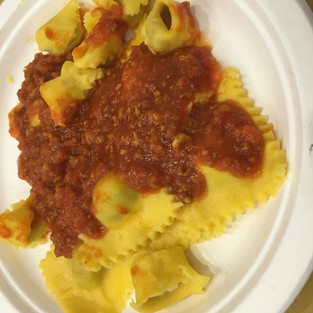Viva Lunga La Pasta Fresca!
- Catherine Doheny

- Dec 1, 2019
- 2 min read
Our final pasta making class was a really exciting time for me because Merinella at Migliore Olive Ascolane went out of her way to make sure that I could learn how to make fresh pasta! Set up in my own little corner I had a brand new rolling pin and cutting board to ensure no gluten would get on my pasta, so incredibly thoughtful.
Marilenna pre-measured the flour that we would need in order to make our dough, 200 grams of flour to two eggs. For gluten free, she reduced it to 180 grams because she didn’t know how well the flour would work, it ended up being perfect! The dough making process was much simpler than I anticipated. To begin, pour the flour into a deep bowl (or on the countertop if you’re skilled and brave) in such a way that it makes a steep pile and from this create a well in which you can add the eggs. Once you crack the eggs in the center you begin the mixing process by beating the eggs and gradually bringing in more flour from the edge ensuring that no clumps are being formed. Eventually it will become so dense that you continue mixing with your hands and then begin to knead it.


--------------------->
Before shaping the pasta you have to let the dough rest so we took this time to learn about comparing the quality of store bought pasta. The most important quality indicators are color, texture, and visible defects, there are many more but these are the ones that you can most easily observe in the store. A fresh pasta will be bright yellow in color while a properly dried pasta will be a more pale yellow. Pasta that was dried too quickly will have a darker amber color indicating the caramelization of sugars. Regarding texture, a more coarse pasta is ideal for the retention of sauce and is an indication of using a bronze die instead of a teflon one which is used in most/all industrial production. Finally, visible defects include white spots (from adding in leftover dough), broken pieces, and cracks (from quick drying).

After this enlightening lesson we returned to our dough and formed ravioli and tortellini! While waiting for these to be cooked we tried pasta made from various grains and indulged in some olive ascolane (Merinella again provided me with a gluten free version). Grazie mille Marinella!












Comments